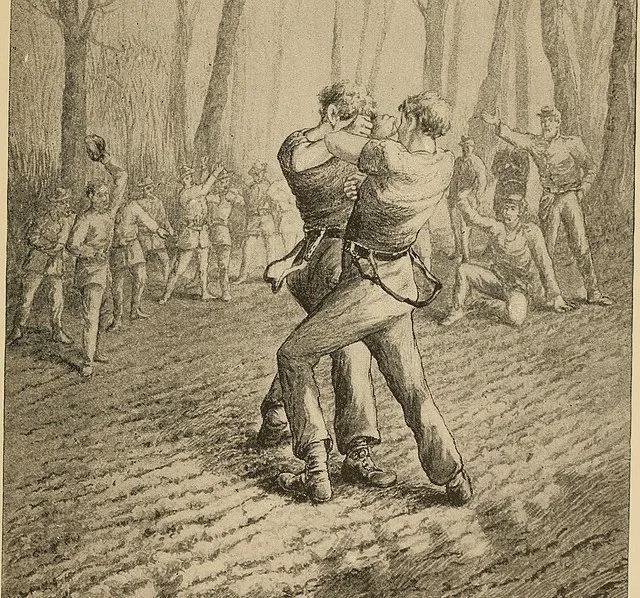“If the northern hemisphere were land, and all the southern hemisphere water, ought we to call the northern hemisphere an island, or the southern hemisphere a lake?” — Augustus De Morgan
The Banner of St. George

A “simple but pretty little puzzle” by Henry Dudeney: If this flag measures 4 feet by 3 feet and presents equal areas of red and white bunting, how wide are the cross’s arms?
What Indeed
The French phrase ouate de phoque (“seal’s cotton wool”) sounds like what the fuck in English.
For whatever that’s worth.
Moveable Feast
Because it depends partly on the phase of the moon, the date of Easter Sunday can vary by as much as 35 days.
In 1928, the Parliament of the United Kingdom passed an act that would establish its date as the Sunday following the second Saturday in April (and thus always falling between April 9 and 15).
Though passed and enacted, the act has never come into force because the British government agreed that the change would need to be made in consultation with church leaders. It’s known as the Easter Act 1928.
(In the meantime, here’s a mnemonic for remembering the current system.)
Matching Sums

A puzzle by Russian mathematician Sergei Berlov:
Here are two decagons. Suppose that a positive integer is written at each of the 20 vertices such that the sum of the numbers around each decagon is 99. Prove that it’s possible to mark some number of successive vertices on each decagon so that the two sums of marked numbers are equal. (The marked segment on a given decagon may be a single vertex, but not all 10.)
Horseplay
I just found this in a 1950 issue of Pi Mu Epsilon Journal:
Question: How many legs has a horse?
Answer: Twelve; two in front, two behind, two on each side, and one in each corner.
Later in the same volume, Marlow Sholander shows that in fact every horse has an infinite number of legs.
That’s to say nothing of color. And see Chasing Leo.
Card Games
Suppose your dog eats the ace of spades and you’re forced to play poker with a 51-card deck. Does this make it more or less likely that you’ll be dealt a two-pair hand?
The answer is not immediately clear. The loss of the ace means that fewer two-pair hands are possible, but the total universe of possible five-card hands is also reduced.
Surprisingly, the probability is unchanged. “[T]he probability of getting a Two-Pair hand in the 51-card deck with the missing Ace of Spades is exactly the same as for a 52-card standard deck,” notes George Mason University mathematician D.M. Anderson. And “[i]t turns out that this seemingly magical result for a deck with a missing Ace of Spades is not limited to Two-Pair hands. Indeed, examining the traditional hierarchy of 5-card poker hands, we find an analogous result holds for One-Pair hands, Three-of-a-Kind, Full Houses and Four-of-a-Kind.”
(D.M. Anderson et al., “Not Playing With a Full Deck?”, Recreational Mathematics Magazine 11:18 [March 2024], 51-63.)
Dammit I’m Mad
Demetri Martin composed this palindromic poem as part of a project for a fractal geometry class at Yale in spring 1993. The first two and last two lines are palindromes, the middle line (“Be still if I fill its ebb”) minus its last letter is a palindrome, and the entire poem is a palindrome:
Dammit I’m mad
Evil is a deed as I live.
God, am I reviled?
I rise, my bed on a sun, I melt.
To be not one man emanating is sad. I piss.
Alas it is so late. Who stops to help? Man, it is hot.
I’m in it.
I tell.
I am not a devil.
I level “Mad Dog”.
Ah, say burning is as a deified gulp
in my halo of a mired rum tin.
I erase many men. Oh, to be man, a sin.
Is evil in a clam? In a trap?
No. It is open.
On it I was stuck.
Rats peed on hope.
Elsewhere dips a web.
Be still if I fill its ebb.
Ew, a spider … eh?
We sleep.
Oh no!
Deep, stark cuts saw it in one position.
Part animal, can I live? Sin is a name.
Both, one … my names are in it. Murder?
I’m a fool. A hymn I plug,
Deified as a sign in ruby ash – a Goddam level I lived at.
On mail let it in. I’m it.
Oh, sit in ample hot spots.
Oh, wet!
A loss it is alas (sip). I’d assign it a name.
Name not one bottle minus an ode by me:
“Sir, I deliver. I’m a dog.”
Evil is a deed as I live.
Dammit I’m mad.
Hand to Hand

An odd incident from the memoir of Lt. John Worsham of the 21st Virginia Infantry — during the Battle of Saunders Field in May 1864, two opposing soldiers found themselves in a gully and agreed to a fistfight to decide which had captured the other:
Then they decided that they would go into the road and have a regular fist and skull fight, the best man to have the other as his prisoner. When the two men came into the road about midway between the lines of battle, in full view of both sides around the field, one a Yankee, the other ‘a Johnny,’ while both sides were firing, they surely created a commotion! This was true in our line and I suppose in the enemy’s line, because both sides ceased firing! When the two men took off their coats and commenced to fight with their fists, a yell went up along each line, and men rushed to the edge of the opening for a better view! The ‘Johnny’ soon had the ‘Yank’ down, who surrendered, and both quietly rolled into the gully, where they remained until night, when ‘the Johnny’ brought ‘the Yank’ into our line. The disappearance of the two men was the signal for the resumption of firing!
This type of story is common, and I haven’t been able to confirm this one, but it’s certainly striking. “Such is war!”
Double Duty
These verses can be interpreted to support either the Stuarts or the Hanovers, according as they’re read. If each is addressed separately, from top to bottom, they’ll seem to support the Hanoverian regime; read together, right across the page, they declare for the Stuarts:

From Reuben Percy, Relics of Literature, 1823.
